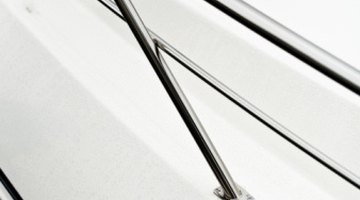How to Seal Fiberglass

Things You Will Need
- Sandpaper, 200 to 300 grit
- Orbital sander (optional)
- Towel
- Fiberglass primer
- Fiberglass paint
- Paint brush
- Clear sealant
Sealing fiberglass is a necessary step to protect and even out the finish. Whether you are sealing a pair of fiberglass doors, a seat or the body of a hot rod, you must complete a few basic steps. Paying attention to your preparation is one of the most important things to do. Fiberglass is slick, and many paints will not stick to it if the proper surface preparation is not complete. Other than that, there are few differences from sealing wood or metal.
-
Rough-sand the surface of the fiberglass using a sanding pad and sandpaper, or orbital sander and sanding disc for larger surfaces. Sand until the fiberglass is flat and as smooth as you want it to be. Keep in mind that the longer you sand, and the finer the grit of sandpaper or sanding disc is, the smoother the finished product will be.
-
Clean away all sanding residue with a dry, clean towel. Apply a fiberglass primer by spraying it on in even strokes using a spray can. Repeat this process until the entire surface is covered. Lightly sand the primer once it is completely dry and there is no tack at all to create a smooth finish. Sanding is optional.
-
Paint the fiberglass with a top coat or stain made for fiberglass paint. Use even strokes again with a spray can or paint brush, and completely cover the entire surface. Let the paint dry completely, following the manufacturer's recommendations for drying time.
-
Push your knuckle into the paint and remove it; if you feel no tack, the paint is dry. You can also rub tape across the surface of the stain, if you used stain, and check to see if the tape retains any color. If not, the stain is dry and you can proceed.
-
Apply a light coat of clear sealant to the fiberglass by brushing it on in even strokes. Allow the sealant to dry and add one more light coat to complete the sealing process. This sealant dries clear, even though it appears opaque during the application process.
References
Writer Bio
Steve Smith has published articles on a wide range of topics including cars, travel, lifestyle, business, golf, weddings and careers. His articles, features and news stories have appeared in newspapers, consumer magazines and on various websites. Smith holds a Bachelor of Arts in English and journalism from University of New Hampshire Durham.
Photo Credits
- Jupiterimages/Photos.com/Getty Images
- Jupiterimages/Photos.com/Getty Images
More Articles



